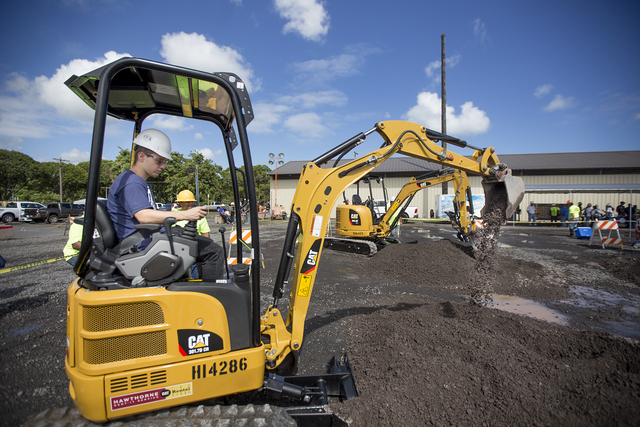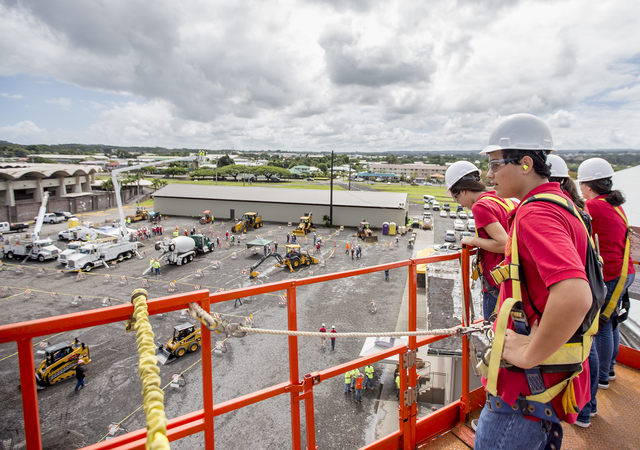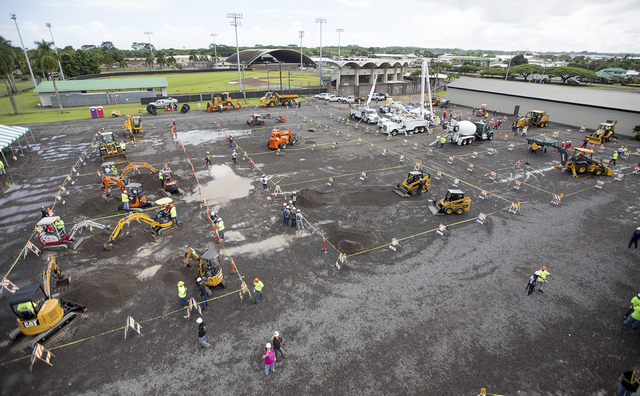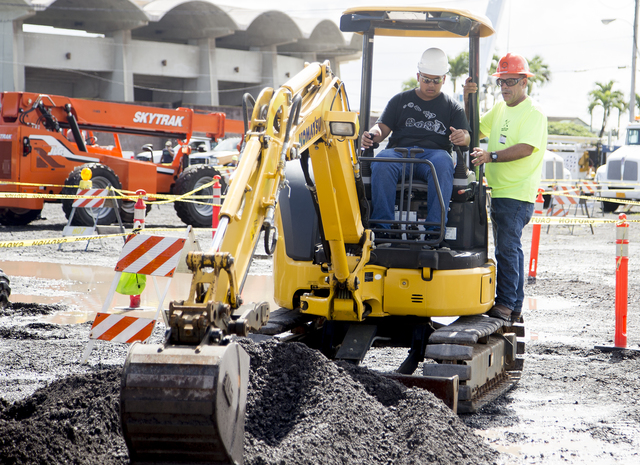The fairgrounds at Hilo’s Afook-Chinen Civic Auditorium were buzzing Thursday with hard-hatted high schoolers, construction industry and union folks, and enough big-boy toys to make Tim Allen grunt with gusto for hours. ADVERTISING The fairgrounds at Hilo’s Afook-Chinen Civic Auditorium
The fairgrounds at Hilo’s Afook-Chinen Civic Auditorium were buzzing Thursday with hard-hatted high schoolers, construction industry and union folks, and enough big-boy toys to make Tim Allen grunt with gusto for hours.
Big Island Construction Career Day 2015 featured hands-on activities for the students, who operated bulldozers, excavators and other heavy equipment, soared high into the sky in bucket and scissor lifts, networked with industry professionals and obtained information on technical schools, universities, scholarships and apprenticeship training programs.
“Construction is booming; there’s a lot of work out there on Oahu, Maui, Big Island, all the islands. The economy is picking up,” said Lamar De Rego, Big Island apprenticeship coordinator and instructor with Laborers’ International Union of North America Local 368.
“Right now, we’re in the process of getting new apprentices,” added Terry Uyehara, a training coordinator for International Brotherhood of Electrical Workers Local 786. “The construction sites on Oahu, Maui, I think, all the islands are picking up.”
Statistics back those optimistic assertions for Hawaii Island. According to September’s report by the county’s Department of Research and Development, building permits authorized in the first nine months of 2015 on the Big Island are valued at $603.66 million, which eclipses the total of $495 million for all of 2014.
At the current rate, building permits could rival the heady numbers put up in 2008, when construction authorizations were valued at $803 million, despite the recession that hit late in the year and caused 2009’s tally to fall to an anemic $426 million.
Organizers say 1,200 students took part, including 50 from Kauai, and those who spoke to the Tribune-Herald enjoyed their close encounters with Caterpillar, John Deere and Komatsu.
Nicholas Hall, a junior at Keaau High School, tried his hand at operating a mini-excavator and called it “quite surprising.”
“If you drive a car, it will just go forward and reverse, and if you turn, it doesn’t happen all at once,” he said. “With that machine, it’s all at once. It was a little bit difficult, but I got the hang of it.”
Hall said his brother-in-law is a drywall foreman considering starting his own business and Hall would like to work for him. According to September statistics from the state Department of Labor and Industrial Relations, the mean yearly income of a drywall and ceiling tile installer is $91,832.
Tehinu Border, a sophomore at Ke Kula O Nawahiokalaniopu‘u, said he’s considering following his father’s footsteps into a construction career.
“It gives you an opportunity to find something you might not find sitting in front of a computer or in school. I would either want to work the crane or be a laborer,” he said.
Chad Naone, an instructor in Local 368’s apprenticeship training school, said those outside the construction industry may underestimate the importance of laborers.
“We’re basically the best-kept secret in the construction industry,” he said. “We do the sewer, water and drains for the (Honolulu) City and County Board of Water Supply. Nobody knows that. We do all the infrastructure. We place the concrete. Without laborers, you’d have nothing made out of concrete. It’d all be made out of bamboo and wood. We have more than 5,000 members in our union. We’re flourishing.”
The boys weren’t the only ones having fun at Thurday’s event. Eve Paguirigan, a Keaau High senior, said she enjoyed the booths “because they had a lot of information and scholarship opportunities, which I really need, because I’m going to college and I need to pay for it.”
Paguirigan said she wants to be a computer engineer, adding, “It’s kind of like where the future’s going.”
It doesn’t appear her career choice would preclude construction industry employment. Computer network architects, who can profit from an engineer’s knowledge of hardware and software, earn a mean annual income of $104,660.
And when it comes to the construction industry, office and computer jobs aren’t the only career paths available.
Nicole Soares, a 27-year-old Honokaa High School graduate and daughter of a drywall installer, is a Hawaii Carpenters Union apprentice, and describes it as “a blast.”
“It’s definitely a male industry,” she said. “But from my experience, I think we need more women out here to keep showing these guys up. I love getting dirty. I love the fact that I’m outdoors, working with my hands and getting stuff done.”
Email John Burnett at jburnett@hawaiitribune-herald.com.






